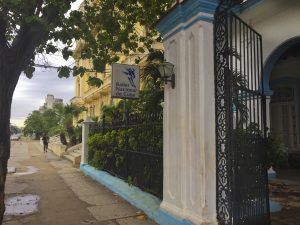Article and photos by Lenore Fedow
Dr. Miguel Cabrera stood before a wall of crooked photo frames in his second-floor office, pointing to pictures of his younger self standing beside dance legends. Just that day, French dancer Benjamin Millepied and his wife, actress Natalie Portman, had been to visit. Over his 47 years as the historian of the National Ballet of Cuba, Cabrera has encountered many of the best-known names in dance, including Martha Graham, Alvin Ailey, Carlos Acosta and, of course, Cuba’s most famous dancer, Alicia Alonso, the founder of the Cuban National Ballet.

Years of study and experience have taught Cabrera almost everything there is to know about the history of Cuban dance, from the ritual areíto of the aboriginal population to the flirtatious zapateo with Hispanic roots to modern Cuban ballet. He recalled the difficulties the company had financing its operations under Gen. Fulgenico Batista’s dictatorship in the 1950s, the company was given only 33,000 pesos a year, which was spent by the end of the first month. In early January 1959, the beginning of the revolution led by Fidel Castro, he visited Alonso in her home and offered his support for the ballet, Cabrera said.
Castro’s support helped, but Cabrera credits the success of the Cuban National Ballet to the ingenuity of Alonso and her husband Fernando. At its beginning, the company struggled to find male dancers. While women were supported, both financially and emotionally, by their families, men faced a challenge, expected to provide for their families, which dancers’ wages did not allow. Men who danced ballet also faced prejudice and had their sexuality questioned. “Girls dancing! My daughter! Beautiful! My boy dancing? No!” recalls Cabrera.
Challenged to attract male dancers, Alonso and her husband sought funding and provided scholarships for poor boys and girls. The couple visited orphanages, looking for talented boys who had no family to object.

The National Ballet taught students from across Cuba, producing las cuatro joyas del ballet Cuban, the four jewels of Cuban ballet: Loipa Araújo, Aurora Bosch, Josefina Méndez and Mirta Plá, who all graduated from Alonso’s school and became four of the most famous dancers in the world.
The National Ballet still produces world-class dancers. Victor Estevez, the principal dancer, was standing in Cabrera’s doorway waiting to say goodbye. Estevez will be a guest at the Queensland Ballet, where he will perform for six months. Cabrera held him in a tight embrace, smiling proudly up at Estevez.
“He is a star, but he is my boy. He’s like my son,” he said. “It’s a happy and sad moment for me. I am proud of him as a dancer and as a human being.”
Cabrera firmly believes in bringing ballet to the people. In Cuba, he said, everyone knows about ballet because it is brought to the schools and taught to children, giving them a glimpse of what it means to dance ballet.
During a visit to the United States, Cabrera recalls buying a ticket to watch his friend, Argentinian-born dancer Herman Cornejo, perform with the American Ballet Theatre. A single ticket cost him $150. Cabrera laments that a worker cannot pay that price, noting that tickets are more affordable in Cuba, around one to five pesos — less than a quarter.
“Art is a very important thing for human beings; the human being doesn’t live off material things,” he said. “It’s necessary to enrich the spirit. That’s what you get from art and culture. In the arts, ballet is a very important area. It’s a very complete art. It’s a very rich expression.”

The Cuban National Ballet is a source of pride for Cuba, a sense of pride that Cabrera feels deeply. “Many people believe that we were influenced by the Soviets,” said Cabrera. “No. Never. Not now. Not before. The Cuban ballet is original,” Cabrera insisted.
Alicia Alonso, the company’s founder, turned 95 in December 2015, and the following month, the Grand Theater of Havana was renamed the Alicia Alonso Grand Theater of Havana. Cabrera said she still has an active role in the company, giving her input on choreography and her advice during rehearsals. When she can longer direct the National Ballet, Cabrera expects that the group of talented teachers will come together to continue her vision and nurture young Cuban dancers.
